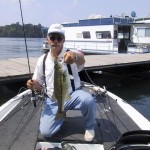Sight Fishing
by: Scott Suggs
By Scott Suggs
Maybe it’s cold outside where you are right now, maybe the lakes are all iced over. Or perhaps the sun is shining and the temperature hasn’t dipped below 70 degrees in a while. Either way, if you consider yourself an angler, it’s time to start thinking about sight fishing.
If you are lucky enough to live somewhere where the weather is warm and sunny right now, then it’s time to start employing sight fishing in order to catch bass. If it’s cold where you are, then that gives you plenty of time to start practicing your skills before the fish head to bedding areas. Some of the year’s biggest fish are caught by sight fishing and it’s easiest to do in clear, shallow water. It can be hard to master but can be very productive for bass and other species once the basics are understood.
Sight fishing involves spotting fish in the water – far easier said than done. In my experiences, I simply look for a shiny or bright spot with a shadow over it. The shiny spot is the bedding area. Big bass will find a place to hang out and then proceed to fan the area clear of algae and debris. This produces the shiny spot; the fish produces the shadow lingering over the bed. Spotting the fish any other way is very difficult because bass have evolved in such a way that the tops of their bodies take on the color of their environment enabling them to stalk their prey more effectively.
To see any of the features and fish beneath the surface, a must-have for anglers is a pair of quality, polarized sunglasses. Different people prefer different colored lenses for sight fishing with each offering advantages and disadvantages. Green lenses are more comfortable but are average in terms of contrast. Gray lenses offer more true color distinction but are lacking in terms of contrast. Amber lenses (preferred by most saltwater anglers) can be uncomfortable in the bright sun but offer the most contrast. There is no right or wrong lens color for sight fishing, only personal preference.
Once a fish is sighted, it is important to understand whether or not the fish is still spawning, protecting fry or just hanging out. If the fish is still spawning or guarding a hatch, it will be protective of its bed and will strike more out of aggression, not necessarily out of hunger. In this case, it will be necessary to cast closer to the fish as it will be less likely to leave its bed unprotected. If the fish is not guarding a bed, cast beyond the fish and retrieve it in front of it to get its attention. If the fish is moving, cast in front of it.
When selecting bait for sight fishing, it is not as necessary to mimic prey as it is to make sure your bait is seen. I prefer to fish brightly colored baits to make sure it grabs the attention of the fish. A large 4-inch Berkley PowerBait Power Flippin’ Tube is ideal rigged with a 4/0 wide gap hook; I like white because it allows me to easily see the bait in the water so I always know where it is in relation to the fish. Line size can also be a factor, so the clearer the water, the smaller the line. To give me the best strength-to-diameter ration, I use Berkley Trilene 100% Fluorocarbon line. It disappears underwater and is less likely to spook line-shy bass that can be especially finicky when on the spawning beds.
Once you’ve found a bed, pitch the bait beyond the bed and work it slowly into the middle. Try to move it to the different sections of the bed, and take careful note of the bass’s reaction with each move. What you’re trying to do is determine where the “sweet spot” of the bed is. The “sweet spot” is the area of the bed – for whatever reason – that, when intruded upon by the bait, elicits an aggressive response from the fish. If the fish gets mad enough, it will strike the bait.
Other baits like a Texas-rigged PowerBait Power Worm or a PowerBait Classic Jig or even a small dropshot rigged with a PowerBait Hand Pour Finesse Worm or other similar-style baits can be effective. But the white tube is a tried-and-true sight fishing bait, one that brought a lot of bass to the boat for me over the years.
Sight fishing is an exciting way to fish for bass. It takes concentration, a keen eye, accurate casting and a requisite amount of stealth to be good at it. If the bass are on the beds right now where you live, go give it a try. If it’s going to be a while before your local fish start the spawning process, then you’ve plenty of time to practice.
Scott Suggs is the 2007 FLW Champion and the first angler in professional bass fishing to win $1 million in a single tournament.

Pingback: Big Georgia Bass and Fishing Clarks Hill | Fishing
Pingback: How and Where To Catch Georgia Spotted Bass | Fishing